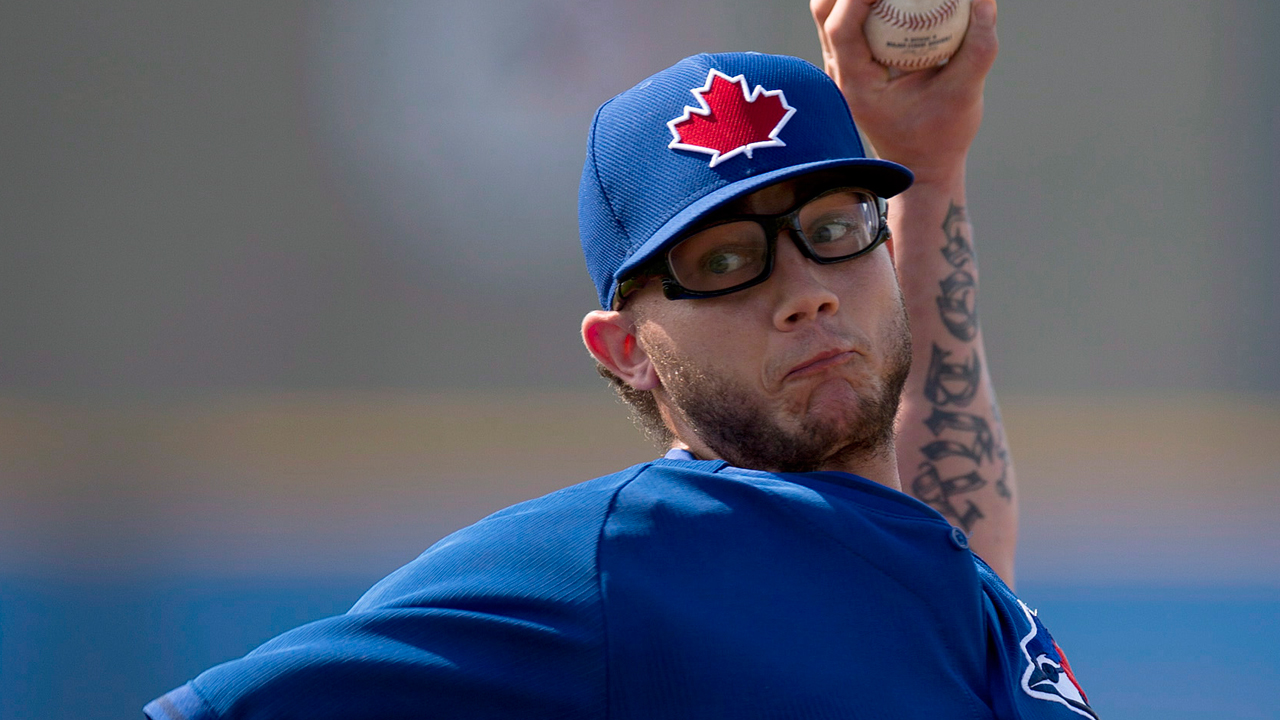DUNEDIN, Fla — It’s a quiet Tuesday afternoon at Florida Auto Exchange stadium, an unusually slow day for the Blue Jays who will play a night game against the Phillies that evening, their only game after dark all spring. Players had the morning off and are slowly filtering into the clubhouse in street clothes and flip flops, finding their bearings under this altered schedule. But then there’s Brett Cecil, dressed in full warm-up gear, whipping a sock with a weighted baseball in it over his shoulder and holding it firm in his follow through.
This is the weighted ball program in action. The arm-strengthening routine was created by Blue Jays consultant Jamie Evans and popularized by hard-throwing Toronto reliever Steve Delabar, who swears it revitalized a pitching career he thought was over. Cecil started doing the program in November 2012 after a frustrating season when the left-hander couldn’t find his form or identity, bouncing between starter and reliever, majors and minors, dependable and wild.
The program significantly increased Cecil’s velocity and when he arrived at spring training in 2013 as a dedicated reliever on a mission to make the major league team his pitches suddenly had regained the life they had when he was a first-round pick six years earlier.
Cecil’s fastball, which had averaged around 90 mph for most of his career, was suddenly up to 92. The same goes for his curveball, which went from 78 to 82, and his changeup, which went from 81 to almost 86. It was one of the biggest factors in Cecil’s remarkable turnaround in 2013, when he asserted himself as one of the Blue Jays’ most reliable relievers and was selected as an American League all-star for the first time in his career.
Everything was going right. Cecil was finding the zone more often than he had since 2009 and inducing the highest rate of swinging strikes of his career. Batters were making less contact against him and he was often working ahead in counts, throwing first-pitch strikes 58.4 percent of the time. Cecil was able to approach relieving with a starter’s repertoire, throwing four-seam fastballs, sinkers, cutters, changeups and curveballs.
“I feel confident throwing every pitch to every hitter,” Cecil says. “I go after guys. What I use is just dependent on the situation that I’m in.”
The most noticeable change in Cecil’s approach was the 27-year-old using his curveball much more often than he had in the past. There was a simple reason for the adjustment.
“Well, it was better,” Cecil says with a laugh. “With the increased arm speed it let me spin the ball tighter and faster and my curveball just had better break to it. My curveball was always 76-79 and then last year it was up to 83. It was just harder to hit. The increased arm strength helps everything.”
Cecil’s season was brilliant up until he left for the All-Star Game in July. His ERA was 1.94 in 41 appearances, which had spanned the spectrum of relief, from long nights eating middle innings to brief, high leverage situations late in games. He had 55 strikeouts to go with just 17 walks in 46.1 innings. Things were going better than he could have imagined.
But when Cecil returned from New York, no one could have anticipated he would pitch just 14.1 more innings and allow nine earned runs, after giving up just 10 in three times as much work before the break. Cecil’s ERA had ballooned from 1.94 to 2.82 on Sept. 12, his last appearance of the season. He was shut down for the year shortly after that, given an early start on the off-season so he could rest his sore elbow.
Cecil, it seems, simply ran out of steam. An extended spring training spent using every opportunity possible to prove he should be on the team had bled into the early regular season when Cecil took on a large, demanding workload. There were side sessions and daily long toss and a stubborn habit of accelerating his work on the weighted ball program when he would have been better served resting his arm. Pitchers are always sore but by August the discomfort in Cecil’s pitching elbow became much more persistent. Nothing was structurally wrong; Cecil was simply doing too much and his arm was no longer willing to cooperate.
“I just needed rest,” Cecil said. “I don’t know what exactly did me in. Whether it was the different workload, the different role, or it could’ve even been the ball program a little bit. It could be all those or it could be one of those. You never know.”
So this year he will do things differently, the focus being on having enough gas left for the end of the season. There will be less throwing when it isn’t necessary and more downtime between appearances. He will try to time his March preparation better so he doesn’t use up too many bullets before they count. He’s moving slower this spring, getting ready for the season more deliberately than he has in the past, which is a convenient perk of being in camp with a roster spot all but secured.
“It takes a little bit of the pressure off,” Cecil said. “I don’t have to worry as much—I can just work to get the arm in shape and get ready for April.”
Whether April will be the beginning of another stellar season or not remains to be seen. Replicating success and performing with consistency can be the hardest things to do as a baseball player. But really, April is just the beginning. It’s the games in September that Cecil is working towards.

